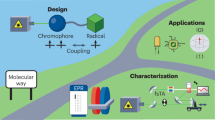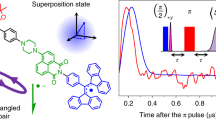Abstract
An anthraquinone modified with a nitroxide radical and able to intercalate into DNA has been synthesized to obtain a molecule the spin state of which can be manipulated by visible light and DNA binding. The doublet ground state of the molecule can be photo-switched to either a strongly coupled spin state (quartet + doublet), when isolated, or to an uncoupled spin state (triplet and doublet), when bound to DNA. The different spin state that is obtained upon photoexcitation depends on the intercalation of the quinonic core into double-stranded DNA which changes the conformation of the molecule, thereby altering the exchange interaction between the excited state localized on the quinonic core and the nitroxide radical. The spin state of the system has been investigated using both continuous-wave and time-resolved EPR spectroscopy.
Similar content being viewed by others
References
S. A. Wolf, Spintronics: A Spin-Based Electronics Vision for the Future, Science, 2001, 294, 1488–1495.
S. D. Bader and S. S. P. Parkin, Spintronics, Annu. Rev. Condens. Matter Phys., 2010, 1, 71–88.
D. Sun, E. Ehrenfreund and Z. Valy Vardeny, The first decade of organic spintronics research, Chem. Commun., 2014, 50, 1781–1793.
A. Bleuzen, V. Marvaud, C. Mathoniere, B. Sieklucka and M. Verdaguer, Photomagnetism in clusters and extended molecule-based magnets, Inorg. Chem., 2009, 48, 3453–3466.
P. Gamez, J. S. Costa, M. Quesada and G. Aromí, Iron Spin-Crossover compounds: From fundamental studies to practical applications, J. Chem. Soc., Dalton Trans., 2009, 7845–7853.
N. Bridonneau, J. Long, J.-L. Cantin, J. von Bardeleben, S. Pillet, E.-E. Bendeif, D. Aravena, E. Ruiz and V. Marvaud, First evidence of light-induced spin transition in molybdenum(IV), Chem. Commun., 2015, 51, 8229–8232.
B. Doistau, J.-L. Cantin, L.-M. Chamoreau, V. Marvaud, B. Hasenknopf and G. Vives, Mechanical switching of magnetic interaction by tweezers-type complex, Chem. Commun., 2015, 51, 12916–12919.
M. Dommaschk, F. Gutzeit, S. Boretius, R. Haag and R. Herges, Coordination-Induced Spin-State-Switch (CISSS) in water, Chem. Commun., 2014, 50, 12476–12478.
P. Gütlich, Y. Garcia and H. A. Goodwin, Spin crossover phenomena in Fe(II) complexes, Chem. Soc. Rev., 2000, 29, 419–427.
S. I. Ohkoshi and H. Tokoro, Photomagnetism in cyanobridged bimetal assemblies, Acc. Chem. Res., 2012, 45, 1749–1758.
O. Sato, Optically Switchable Molecular Solids: Photoinduced Spin-Crossover, Photochromism, and Photoinduced Magnetization, Acc. Chem. Res., 2003, 36, 692–700.
K. Takayama, K. Matsuda and M. Irie, Photoswitching of the Magnetic Interaction between a Copper(II) Ion and a Nitroxide Radical by Using a Photochromic Spin Coupler, Chem. – Eur. J., 2003, 9, 5605–5609.
C. M. Niemeyer, Self-assembled nanostructures based on DNA: Towards the development of nanobiotechnology, Curr. Opin. Chem. Biol., 2000, 4, 609–618.
C. F. J. Faul and M. Antonietti, Ionic self-assembly: Facile synthesis of supramolecular materials, Adv. Mater., 2003, 15, 673–683.
S. Zhang, Fabrication of novel biomaterials through molecular self-assembly, Nat. Biotechnol., 2003, 21, 1171–1178.
S. Kogikoski, W. J. Paschoalino and L. T. Kubota, Supramolecular DNA origami nanostructures for use in bioanalytical applications, TrAC, Trends Anal. Chem., 2018, 108, 88–97.
J. P. Watt, G. F. Davies, R. J. O. Connell, R. Geo-, S. Phys, J. Schlittenhardt, B. Seismol, S. Am, M. Weber, F. D. Lewis, T. Wu, Y. Zhang, R. L. Letsinger, S. R. Greenfield and M. R. Wasielewski, Distance-Dependent Electron Transfer in DNA Hairpins, Science, 1997, 277, 673–676.
R. Carmieli, A. K. Thazhathveetil, F. D. Lewis and M. R. Wasielewski, Photoselective DNA Hairpin Spin Switches, J. Am. Chem. Soc., 2013, 135, 10970–10973.
F. D. Lewis, R. L. Letsinger and M. R. Wasielewski, Dynamics of photoinduced charge transfer and hole transport in synthetic DNA hairpins, Acc. Chem. Res., 2001, 34, 159–170.
B. Albinsson, J. K. Hannestad and K. Börjesson, Functionalized DNA nanostructures for light harvesting and charge separation, Coord. Chem. Rev., 2012, 256, 2399–2413.
M. Palumbo and B. Gatto, Molecular Basis of Specificity in Nucleic Acid-drug Interactions, Proceedings of the Twenty-third Jerusalem Symposium on Quantum Chemistry Ano Biochemistry Held in Jerusalem, Israel, 1990, ed. Bernard Pullman Institut de Biologie Physico-Chimique (Fondation Edmond de Rothschild), Paris, France and JOSHUA JORTNER Department of Chemistry, University of Tel-Aviv, Israel, 1990, pp. 207–224.
B. Gatto, G. Zagotto, C. Sissi, C. Cera, E. Uriarte, G. Palù, G. Capranico and M. Palumbo, Peptidyl anthraquinones as potential antineoplastic drugs: Synthesis, DNA binding, redox cycling, and biological activity, J. Med. Chem., 1996, 39, 3114–3122.
G. Zagotto, R. Supino, E. Favini, S. Moro and M. Palumbo, New 1,4-anthracene-9,10-dione derivatives as potential anticancer agents, Farmaco, 2000, 55, 1–5.
M. Bortolus, A. Ferrarini, J. Van Tol and A. L. Maniero, Full determination of zero field splitting tensor of the excited triplet state of C60 derivatives of arbitrary symmetry from high field TREPR in liquid crystals, J. Phys. Chem. B, 2006, 110, 3220–3224.
M. Bortolus, M. Prato, J. van Tol and A. L. Maniero, Timeresolved EPR study of fullerene C60 adducts at 240 GHz, Chem. Phys. Lett., 2004, 398(1–3), 228–234.
Y. Kandrashkin and A. van der Est, Electron spin polarization of the excited quartet state of strongly coupled triplet–doublet spin systems, J. Chem. Phys., 2004, 120, 4790–4799.
J. Fujisawa, Y. Iwasaki, Y. Ohba, S. Yamauchi, N. Koga, S. Karasawa, M. Fuhs, K. Möbius and S. Weber, Excited quartet and doublet states in the complex of tetraphenylporphine zinc(II) and a nitroxide radical in solution: X- and W-band time-resolved EPR studies, Appl. Magn. Reson., 2001, 21, 483–493.
Y. Teki, M. Kimura, S. Narimatsu, K. Ohara and K. Mukai, Excited High-Spin Quartet (S = 3/2) State of a Novel π-Conjugated Organic Spin System, Pyrene-Verdazyl Radical, Bull. Chem. Soc. Jpn., 2004, 77, 95–99.
Y. Teki, S. Miyamoto, K. Iimura, M. Nakatsuji and Y. Miura, Intramolecular spin alignment utilizing the excited molecular field between the triplet (S = 1) excited state and the dangling stable radicals (S = 1/2) as studied by timeresolved electron spin resonance: Observation of the excited quartet (S = 3/2) and quintet (S = 2) states on the purely organic π-conjugated spin systems [18], J. Am. Chem. Soc., 2000, 122, 984–985.
L. Franco, M. Mazzoni, C. Corvaja, V. P. Gubskaya, L. S. Berezhnaya and I. A. Nuretdinov, First observation of the hyperfine structure of an excited quintet state in liquid solution, Chem. Commun., 2005, 2128.
L. Franco, M. Mazzoni, C. Corvaja, V. P. Gubskaya, L. S. Berezhnaya and I. A. Nuretdinov, TR-EPR of single and double spin labelled C 60 derivatives: observation of quartet and quintet excited states in solution, Mol. Phys., 2006, 104, 1543–1550.
Y. Teki, M. Nakatsuji and Y. Miura, Spin alignment between the triplet excited state of phenylanthracene and the dangling verdazyl radical as studied by time-resolved electron spin resonance, Int. J. Mod. Phys. B, 2001, 15(28n30), 4029–4031.
R. Hanaishi, Y. Ohba, K. Akiyama, S. Yamauchi and M. Iwaizumi, Observation of spin-correlated radical pairs via two-dimensional electron paramagnetic resonance nutation spectroscopy, J. Chem. Phys., 1995, 103, 4819–4822.
A. Kawai, Dynamic electron polarization created by the radical-triplet pair mechanism: Application to the studies on excited state deactivation processes by free radicals, Appl. Magn. Reson., 2003, 23, 349–367.
S. Stoll and A. Schweiger, EasySpin, a comprehensive software package for spectral simulation and analysis in EPR, J. Magn. Reson., 2006, 178, 42–55.
M. D. Hanwell, D. E. Curtis, D. C. Lonie, T. Vandermeersch, E. Zurek and G. R. Hutchison, Avogadro: an advanced semantic chemical editor, visualization, and analysis platform, J. Cheminf., 2012, 4, 17.
F. Neese, The ORCA program system, Wiley Interdiscip. Rev.: Comput. Mol. Sci., 2012, 2, 73–78.
F. Neese, Software update: the ORCA program system, version 4.0, Wiley Interdiscip. Rev.: Comput. Mol. Sci., 2018, 8, 4–9.
A. Navas Diaz, Absorption and emission spectroscopy and photochemistry of 1,10-anthraquinone derivatives: a review, J. Photochem. Photobiol., A, 1990, 53, 141–167.
A. Ricci, J. Marinello, M. Bortolus, A. Sánchez, A. Grandas, E. Pedroso, Y. Pommier, G. Capranico, A. L. Maniero and G. Zagotto, Electron paramagnetic resonance (EPR) study of spin-labeled camptothecin derivatives: A different look of the ternary complex, J. Med. Chem., 2011, 54(4), 1003–1009.
C. X. Xu, X. Zhang, Y. W. Zhou, H. Wang, Q. Cao, Y. Shen, L. N. Ji, Z. W. Mao and P. Z. Qin, A Nitroxide-Tagged Platinum(II) Complex Enables the Identification of a DNA G-Quadruplex Binding Mode, Chem. – Eur. J., 2016, 22, 3405–3413.
P. Belmont, C. Chapelle, M. Demeunynck, J. Michon, P. Michon and J. Lhomme, Bioorg. Med. Chem. Lett., 1998, 8(6), 669–674.
M. Montalti, A. Credi, L. Prodi and M. Teresa Gandolfi, Handbook of Photochemistry, CRC Press, 3rd edn, 2006.
F. D. Lewis, A. K. Thazhathveetil, T. A. Zeidan, J. Vura-Weis and M. R. Wasielewski, Dynamics of ultrafast singlet and triplet charge transfer in anthraquinone-DNA conjugates, J. Am. Chem. Soc., 2010, 132, 444–445.
R. Carmieli, A. L. Smeigh, S. M. Mickley Conron, A. K. Thazhathveetil, M. Fuki, Y. Kobori, F. D. Lewis and M. R. Wasielewski, Structure and dynamics of photogenerated triplet radical ion pairs in DNA hairpin conjugates with anthraquinone end caps, J. Am. Chem. Soc., 2012, 134, 11251–11260.
S. Yamauchi, Recent Developments in Studies of Electronic Excited States by Means of Electron Paramagnetic Resonance Spectroscopy, Bull. Chem. Soc. Jpn., 2004, 77, 1255–1268.
V. F. Tarasov, S. S. M. Islam, Y. Ohba, M. D. E. Forbes and S. Yamauchi, Multifrequency TREPR Investigation of Excited-State ZnTPP/Nitroxide Radical Complexes, Appl. Magn. Reson., 2011, 41, 175–193.
C. Corvaja, M. Maggini, M. Ruzzi, G. Scorrano and A. Toffoletti, Spin polarization in fullerene derivatives containing a nitroxide group. Observation of the intermediate photoexcited quartet state in radical triplet pair interaction, Appl. Magn. Reson., 1997, 12, 477–493.
N. J. Turro, I. V. Khudyakov, S. H. Bossmann and D. W. Dwyer, An electron spin polarization study of the interaction of photoexcited triplet molecules with mono- and polynitroxyl stable free radicals, J. Phys. Chem., 1993, 97, 1138–1146.
Distance Measurements in Biological Systems by EPR, ed. L. J. Berliner, G. R. Eaton and S. S. Eaton, Springer US, Boston, MA, 2002, vol. 19.
J. S. Kahn, Y. Hu and I. Willner, Stimuli-Responsive DNA-Based Hydrogels: From Basic Principles to Applications, Acc. Chem. Res., 2017, 50, 680–690.
Y. Hu, A. Cecconello, A. Idili, F. Ricci and I. Willner, Triplex DNA Nanostructures: From Basic Properties to Applications, Angew. Chem., Int. Ed., 2017, 56, 15210–15233.
J. Zhang, J. Wang and H. Tian, Taking orders from light: Progress in photochromic bio-materials, Mater. Horiz., 2014, 1, 169–184.
Author information
Authors and Affiliations
Corresponding author
Additional information
Electronic supplementary information (ESI) available: Syntheses, calculation details, additional EPR data, and full experimental procedures. See DOI: 10.1039/c8pp00586a
Rights and permissions
About this article
Cite this article
Bortolus, M., Ribaudo, G., Toffoletti, A. et al. Photo-induced spin switching in a modified anthraquinone modulated by DNA binding. Photochem Photobiol Sci 18, 2199–2207 (2019). https://doi.org/10.1039/c8pp00586a
Received:
Accepted:
Published:
Issue Date:
DOI: https://doi.org/10.1039/c8pp00586a




